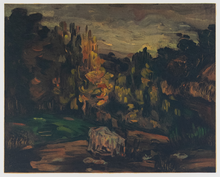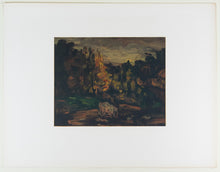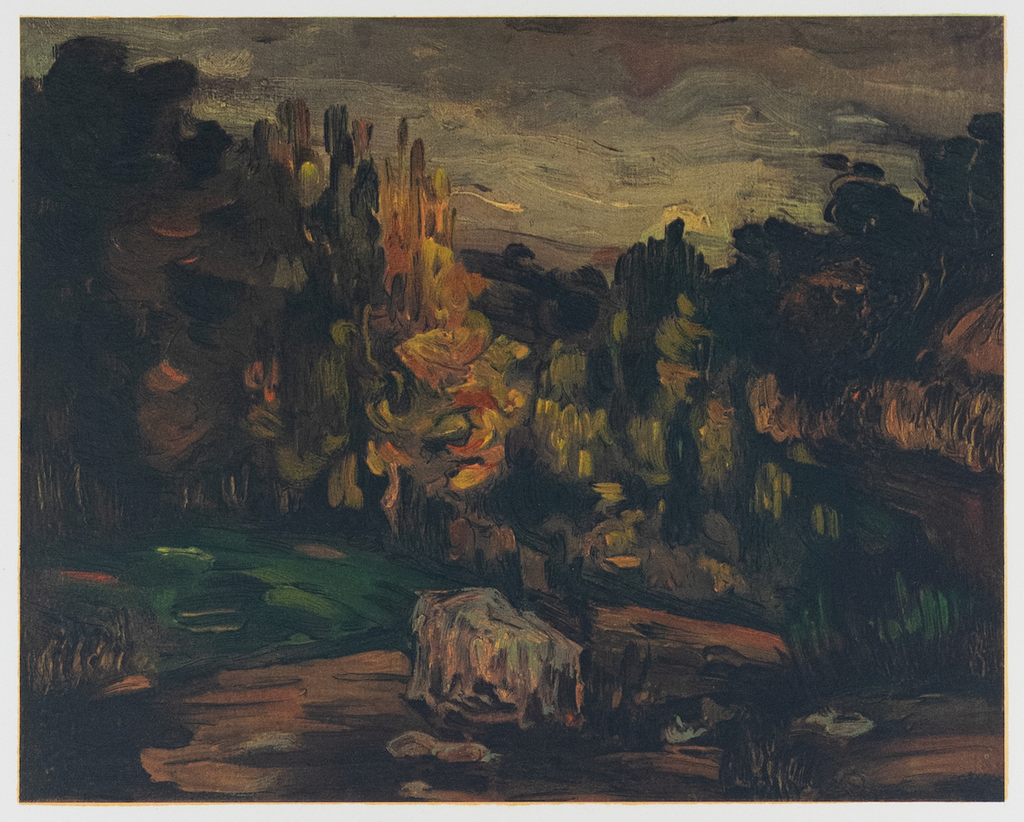Paul Cézanne (1839 - 1906)(after)
NAME: Paysage à Aix
ENGLISH NAME: Landscape in Aix
MEDIUM: Color lithograph
SIGNATURE: Signed in the plate
ABOUT:
This album, the eighth in a series devoted to the collection of Mr. Pierre Lévy, has a print run of 1000 on Arches vellum. Completed to print on November 23, 1973 by Mourlot for the reproductions of the paintings of the REALISTES LYRIQUES and by Fequet and Baudier for La typographie.
Fernand Mourlot, Paris, 1973.
IMAGE is ACTUAL WORK
Please contact us to request further information or additional images.
Possible browning of arches paper due to age, but image is in excellent condition.
Paul Cézanne (1839 – 1906) a French artist in Aix-en-Provence, France and his father was a co-founder of a bank that provided Paul financial security not afforded his peers. He is attributed to forming a bridge between 19th century Impressionism and 20th century new artistry. He was considered “the father” by Matisse and Picasso.
In 1852 he ventured to the Collège Bourbon in Aix where he met Émile Zola and they became close friends. In 1858, he attended law school to appease his father. Against his father’s wishes, in 1861 he dedicated his time to his pursuit and development as an artist full time. He left in 1861 to go to Paris at the encouragement of Zola who was already there. Overtime he reconciled with his father and his father assisted him. He eventually inherited 400,000 francs and became financially independent for life.
In the mid-1860s a friendship or rather a master – disciple relationship formed with Camille Pissarro. Pissarro is thought to have a great influence over Cézanne during the next decade.
His goal during this time was to make impressionism something solid. He seemed focused on simplifying forms to their geometric pattern. A tree is a cylinder, an apple a sphere, etc.
Cézanne is said to have three periods of work.
The Dark Period (1861-1870)
In 1863 Napoleon III created the Salon des Refusés for the artist that were rejected by the Salon of the Académie des Beaux-Arts. Cézanne exhibited here and his works have dark colors and there is a heavy use of black. This differs greatly from his early work in watercolors and sketches when at École Spéciale de dessin at Aix-en-Provence.
In 1866-67 he painted a series of works with a palette knife stating they were a course word. Furthering the notion that this was a dark period, his works of Women Dressing (1867), The Rape (1867) and the Murder (1867-68) show this to be true.
The Impressionist Period (1870 – 1878)
In 1870, Cézanne and his mistress left Paris where he did mostly landscapes. He was thought to be a draft dogger in 1871. After his son, Paul, was born he moved to Auvers in Val-d’Oise. At this point, Cézanne was getting 100 francs from his father. While in Auyers, he painted beside Pissarro. It was Pissarro that pulled Cézanne out of the dark side and his canvases grew brighter. He traveled between Paris and Provence and showed many shows. In addition, he painted with Renoir in 1882 and visited Renoir and Monet in 1883.
Mature Period (1878 – 1890)
Cézanne is getting settled. He marries Hortense in 1886 and his father dies that year leaving hism the estate.
Final period (1890–1906)
Cézanne did not flourish in his latter part of life. He was seen as a recluse and spent many long periods in the studio. He is known for the Skulls during this period and it is believed that his resignation to death brought on by the onset of diabetes. The skulls themselves are still in Cézanne’s studio in Aix.
He died in 1906 and his studio became a monument.







